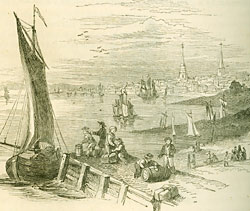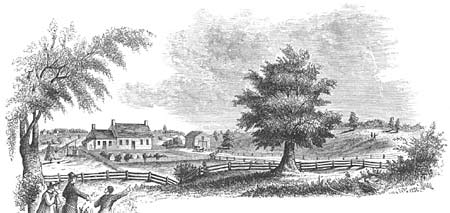Battle of Monmouth, N.J., 1778-Autumn 1779
In London the events of 1777 made the government decide that a change of command was needed in America, but Lord George Germain, the Secretary for America, did not wish to dismiss both the Howe brothers. Sir Henry Clinton was appointed in General Howe's place, a matter which he viewed with very mixed feelings. The treatment of his predecessors by the government did not inspire confidence. The actual terms of his appointment were so circumscribed that in the event of failure to carry out strategy agreed on in London he was to carry the whole blame irrespective of his own feelings on the possible success of a particular campaign.
The friction between Lord George Germain and Sir Henry Clinton was a constant underlying current of the events of the next three years, and it is difficult to escape the conclusion that Clinton was very shabbily treated. For example, on 31st May 1779, Lord George's records stated that Clinton was in command of 47,661 men, and that therefore, Clinton's requests for reinforcement were the result of timidity and indolence, a judgment which has been made on Clinton ever since. Lord George's figures included every man, trained or untrained, sick or wounded, missing or captured whose name had once been entered on a regimental list. To the commander in the field the calculation was absurd, and a deliberate attempt to mislead parliament.

Philadelphia, Pennsylvania, 1777
From The Popular History of England by Charles Knight, Vol. VI (London: Bradbury and Evans, 1860)
That summer there were troops in Halifax, Newfoundland, Florida and Georgia, troops in transit from Britain, and a further consignment of 6,000 in the West Indies, which when returned to the main force in New York proved to have fewer than 3,800 men fit. Furthermore the diseases which these soldiers brought with them quickly spread to the rest of the army. Clinton had between 1778 and 1781 a working army, fit and effective, which never exceeded 20,000 men, and the defence of New York was judged to require 10,000 men. Clinton's margin for fighting offensive campaigns was never more than 10,000 men.
Sir Henry Clinton's first task as commander-in-chief was to evacuate Sir William Howe's army from Philadelphia, and concentrate it in New York. The new danger lay in the possible arrival of a French fleet and army, which could attack the British bases from the sea.
The government in London expected Philadelphia to be evacuated by the navy, but the number of troops and loyalist supporters involved made that impracticable. Sir Henry Clinton decided on a march across New Jersey. The British army was very vulnerable on this march, since the column making its way to New York was more than twelve miles long. The army had to be split in two at the head and rear of the column, with the baggage train and civilians in between.
The American forces under Washington started in pursuit, and 1,500 men under Colonel Charles Scott were assigned to harass the British left flank. With Washington pressing him so close Clinton decided not to continue to New York overland but aim for Sandy Hook, and rely on the navy to ferry him from there. Clinton reached Monmouth, New Jersey, on the afternoon of the 26th June, after an exhausting 19 miles march in temperatures that reached 38°C. The following day the British expected an attack, which did not come; so on the morning of the 28th the retreat continued. The American advance guard under General Charles Lee caught up with the British rear guard that morning.

Battleground at Monmouth
From Pictorial Field Book of the Revolution, by Benson J. Lossing
The battle which followed was a confused one. At no point were the whole of the American and British forces engaged. At first the British were successful but the arrival of Washington and American reinforcements added to the British problems. Once again probably the decisive factor was temperature. By noon the troops on both sides were exhausted by the heat [see Document 5] but the battle continued until 5 o'clock without a determining conclusion. Many of the troops on both sides collapsed from heat exhaustion. Clinton withdrew his army at midnight, and hastened to join up with the baggage train. The British forces reached Sandy Hook on the 29th where they were met by the navy.
It was not a victory for either side, but on the other hand Clinton had successfully achieved his objective. By July a French fleet had appeared in America under Admiral D'Estaign, and troops began to be detached for other posts, much to Clinton's frustration. This situation continued for a full year, with detachments sent to Nova Scotia, Florida and the West Indies on London's orders, and there were no replacements before September 1779 [see Document 6] Relations between Clinton and London were so bad that he attempted to resign his post on several occasions. His frustrations were compounded by the inadequacies of the naval commander Admiral Arbuthnot, whom Clinton firmly believed was past being able to cope with an active command.
Next page: Charlestown and the South, 1779-1780